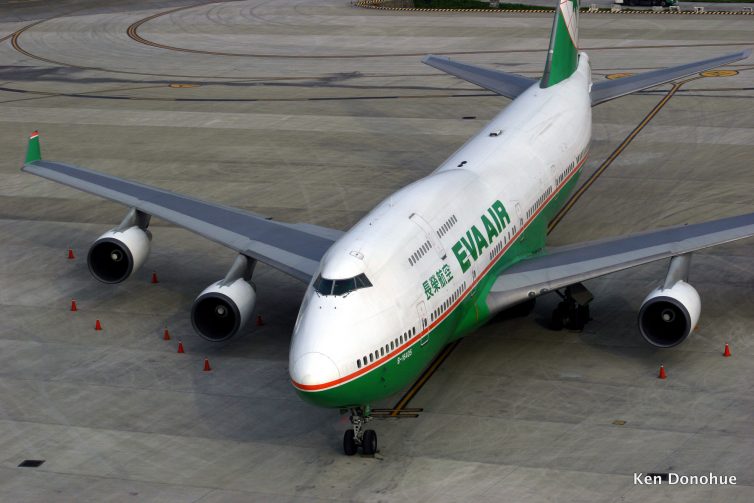
EVA Air Boeing 747-400
There is little question that the Boeing 747 is the most beautiful aircraft ever built. It’s in a class of its own. There’s a reason it’s called the Queen of the Skies.
While some modifications (just a few) have been made since the first one took to the skies in 1969, its design is timeless. From the pointed nose that rises gracefully up to the cockpit windows and that distinctive hump.
For decades, it was the undisputed leader in wide-body aircraft. With more than 1,500 ordered, airlines that flew the 747 gained instant credibility and cachet. Bigger isn’t always better, and while the Airbus A380 may be the biggest commercial airplane, it has nothing on the 747’s style and panache. The 747 is a glamorous runway model that turns heads wherever it goes – the way it struts confidently through airports around the globe. And nose onrotating off the runwayit’s a thing of beauty.
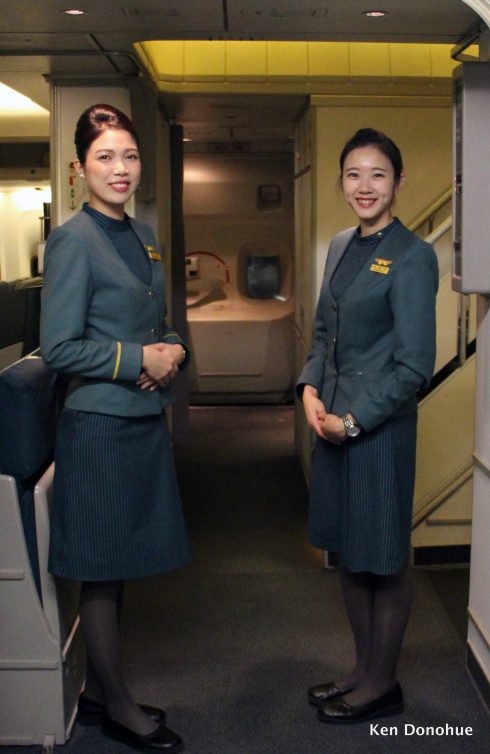
Flight attendants welcome me onboard
All good things must end, and so it is that the 747 is in its twilight yearseclipsed by the more efficient Boeing 777, bigger Airbus A380, and fuel-sipping Boeing 787/Airbus A350. With only 41 Boeing 747-8Is ordered, the writing’s on the wall. And in the coming decade, we will see fewer and fewer Boeing 747s. But there are still some airports where you can see the Queen, and take one last flight. Such is the case with my home airport in Vancouver (YVR), where EVA, China Airlines, Lufthansa, British Airways, and Qantas still have passenger operations with the type. Albeit, the latter three operate the aircraft only seasonally. This past year, BA began using the Airbus A380 in summer months, but reverts to the 747 in the winter months. Lufthansa is now the only carrier operating daily 747 passenger service to Vancouver.
AirlineReporter recently experienced EVA Air’s Boeing 747 service on the Vancouver-Taipei-Vancouver sector. The 747 once made up the bulk of EVA’s long-haul fleet. It was the aircraft the Taiwanese airline used on its first flight to North America, when it inaugurated service to Los Angeles in December, 1992. Like many airlines, EVA has been replacing its 747s with Boeing 777s, which now do most of the airline’s long-haul flying. In fact, the airline now only has three passenger 747s left in its fleet, and Vancouver is one of the few destinations to which EVA uses the aircraft. EVA executives recently told me that 747 will no longer fly the Vancouver route by July 2017, and will be completely retired from the airline’s fleet by September of next year.
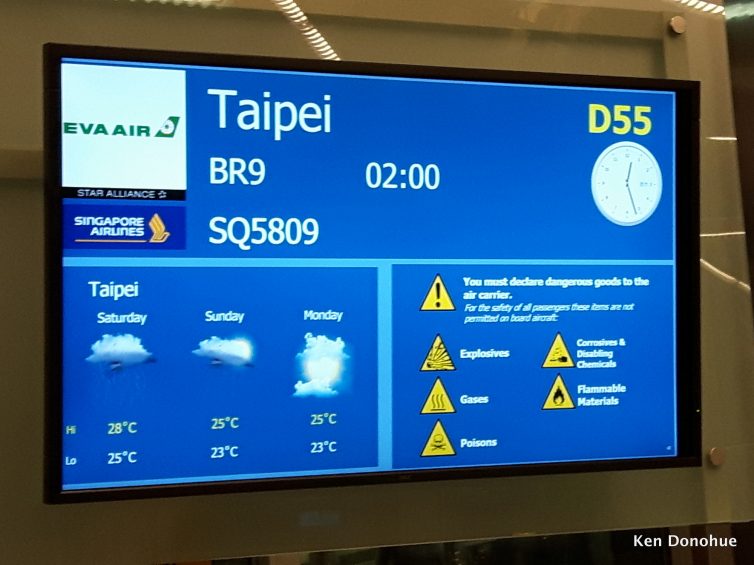
Let’s get ready to fly!
Boeing 747-400
Vancouver (YVR) ’“ Taipei (TPE)
Elite (Premium Economy)
With a flight departure time of 02:00, the check-in counters at YVR were busy around midnight. In fact, the international terminal was a hive of activity, with two flights to Taipei, one to Hong Kong, and another heading back to Manila. Given the number of passengers departing, the security queue was unusually long for the time of day. In fact, it took an hour to check-in and clear security.
- The premium economy cabin on EVA’s 747-400
- In a 2-4-2 configuration
I settled into seat 26K, the last row in the Elite cabin. EVA was the first airline in the world to introduce premium economy when it first flew to Los Angeles almost 25 years ago. That early iteration was known as Evergreen Deluxe, and most of the seats on the aircraft at the time were of this type, with only a small economy class section in the rear of the aircraft. Over time, the airline rationalized its configuration and now offers a smaller 56-seat premium economy cabin. Seats in Elite class come with a comfortable ’¨38-inch pitch, compared to (the very generous) 33 inches in the economy cabin, and a wider seat at 19.5 inches. Passengers in Elite are also provided with an amenity kit.
BONUS: Flying on the Upper Deck of a EVA Air Boeing 747-400 — in Economy
With an announced flying time of almost 12 hours, pushback was on schedule at 02:00, and 14 minutes later we were at the end of runway 08R, and with no delay commenced our takeoff roll. Climbing out under cloudy skies to the east, which is typical during inclement weather, we banked to the right past the BC Ferries Tsawwassen terminal and across the Strait of Georgia tracking across Vancouver Island. By 02:33, we had reached 30,000 feet and we settled into our route that would take us 6,140 miles (9,880 km) along the coast of British Columbia and Alaska, passing over Russia and then later Japan, before making for the northern tip of Taiwan.
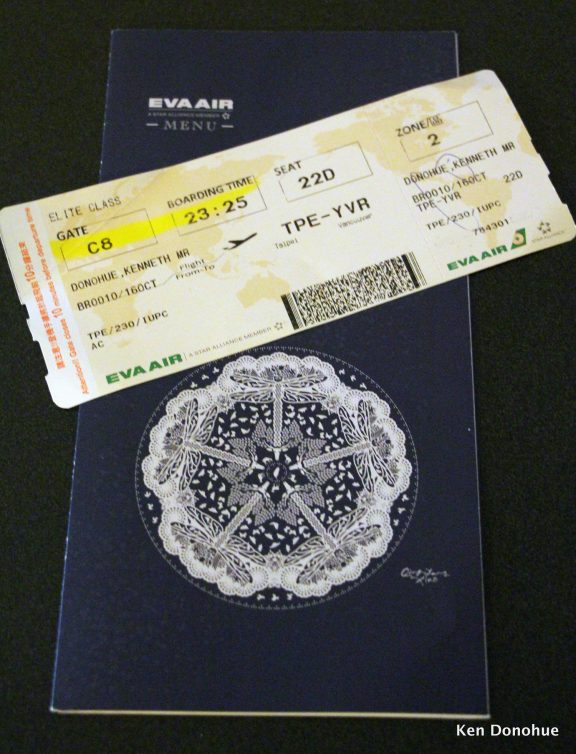
My ticket and dinner menu
Once we had reached our cruising altitude, cabin attendants brought around juice and warm towels, along with a dinner menu. Soon after, the meal service commenced, though it would have been nice had the trash been collected before serving the meal. EVA has quietly been known for having good catering on its flights, and on this flight dinner began with a starter of smoked duck breast with pineapple salsa, and a choice of two main dishes. I chose the stir-fried vermicelli with prawns. It didn’t disappoint.
BONUS: Flying on an EVA Air Hello Kitty Boeing 777-300ER
A credit to EVA is that despite the Boeing 747s being the oldest aircraft in their fleet, the cabins are well maintained. The Elite-class seats, in a 2-4-2 configuration, are covered in a pleasing green-hued fabric and have a 38-inch seat pitch.
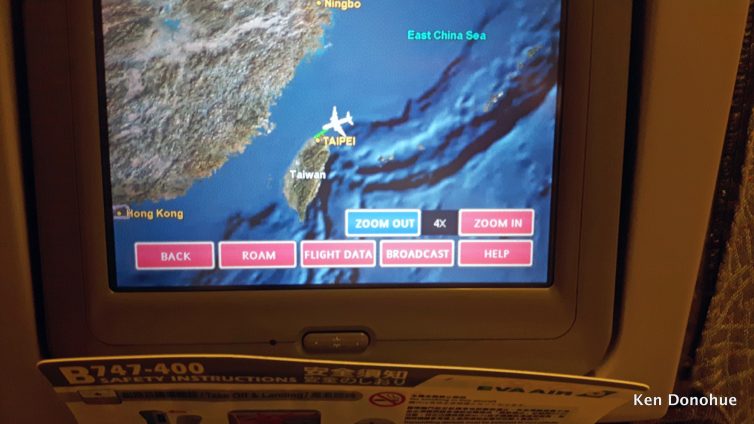
The in-seat screen
The Star Gallery inflight entertainment system, with an 11-inch screen, was very extensive, and while I am not much of a movie person, I did appreciate the wide selection of music on offer, and Elite passengers are provided with headphones that are of better quality than those in economy. Despite a recent refresh, I continue to find the uniforms of the cabin attendants to be a little dated. I don’t know if it’s the dark green color, but they lack a little pizzazz.
Approximately two-and-a-half hours before arriving in Taipei, a breakfast service was offered.
BONUS: EVA Air Shows Off New Livery on Boeing 777-300ER
At 05:12 local time we touched down on runway 05R and taxied to Gate C6. Most flights from EVA’s North American network arrive in the early morning hours, allowing passengers to easily connect throughout Asia.
My return flight was of similar quality that I have come to expect from EVA. Boarding commenced at 23:25, and pushback at midnight. Other EVA flights to Seattle and Los Angeles were also departing at the same time. After waiting at the end of runway 05R for five minutes, wheels were up at 00:20. A dinner service was offered shortly after takeoff. Not wanting a heavy meal, I asked if I could just have the fruit. The cabin attendant obliged and gave me the fruit, some salad, and dessert.
BONUS: Photo Tour of Evergreen’s Maintenance Facility in Taipei
There were two blemishes on EVA’s usual stellar service. The toilet paper rolls in one lavatory were empty on one occasion, and the cabin was extremely cold. It was as if someone had left a window open. I noticed passengers wearing coats, and one even had a toque on. Normally, I’m okay with cooler temperatures, but even I had to resort to putting a blanket around me.
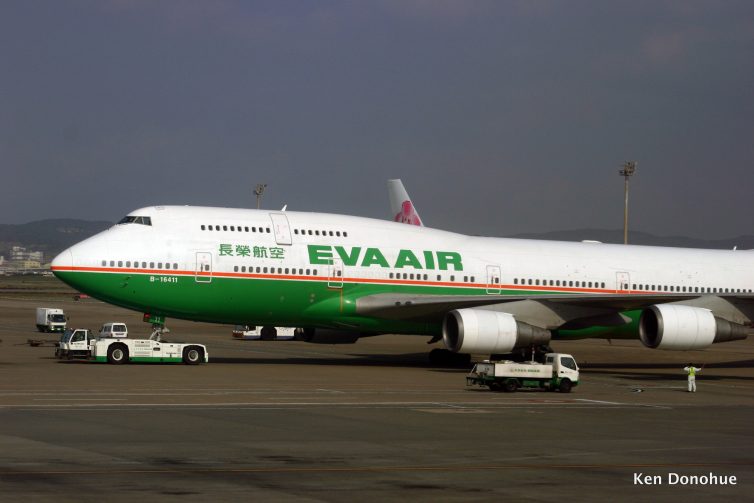
A beautiful bird that will soon no longer be flying
Elite class is a great product for a long-haul flight. The larger seats and more space is welcomed on long flights. Does EVA live up to its five-star distinction? Overall, I would suggest they do; however, the airline should never be satisfied with past accolades. In dramatic fashion, there were changes to EVA’s senior executive and Board chair earlier this year. Time will tell if the airline can continue its rise as one of the world’s best airlines.
This story was written by Ken Donohue for AirlineReporter. Curious by nature, inspired by flight, fascinated by the places, people, and stories that make flying possible, Ken is based in Vancouver. You can see more of his work at www.kendonohue.com.
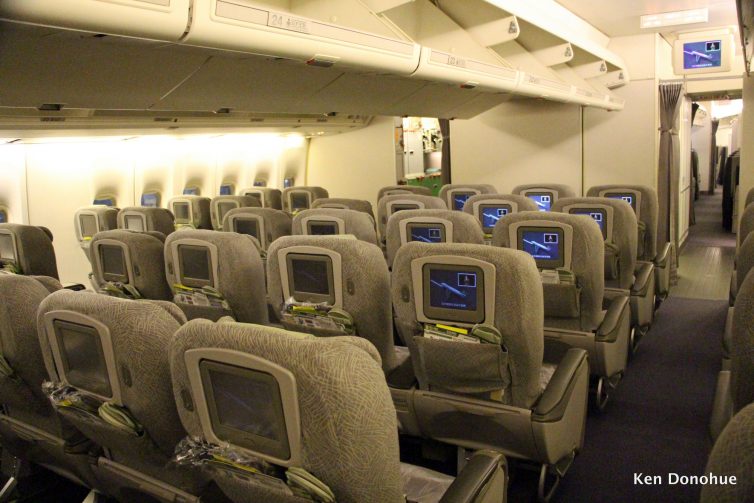
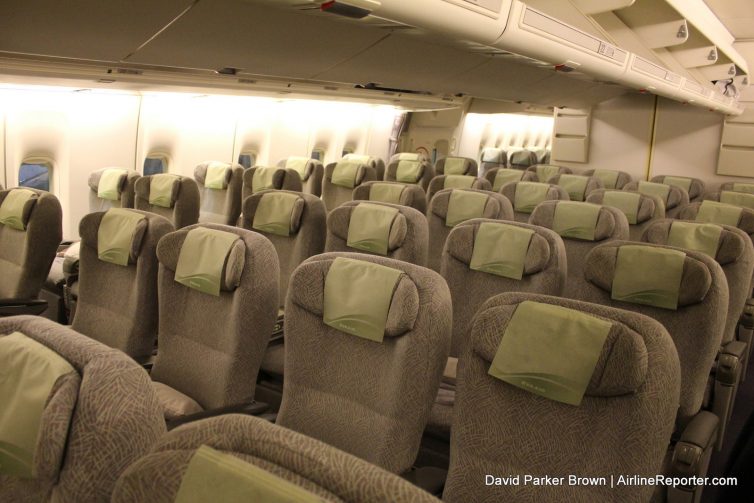
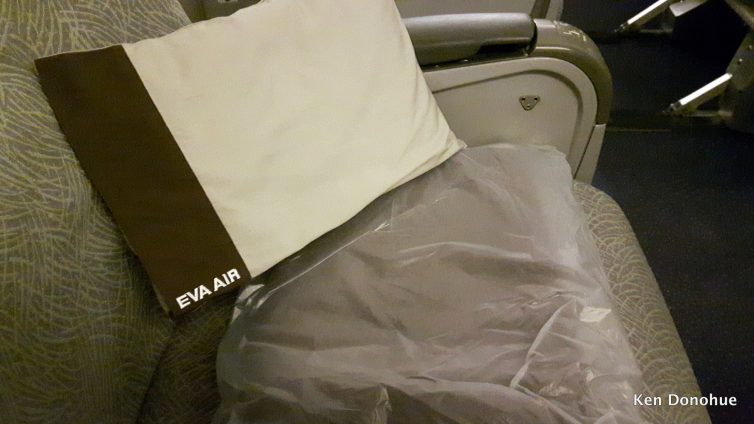
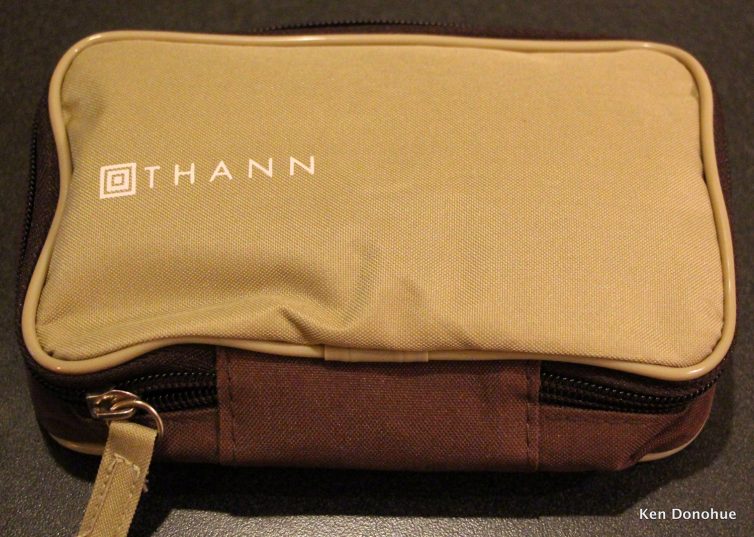
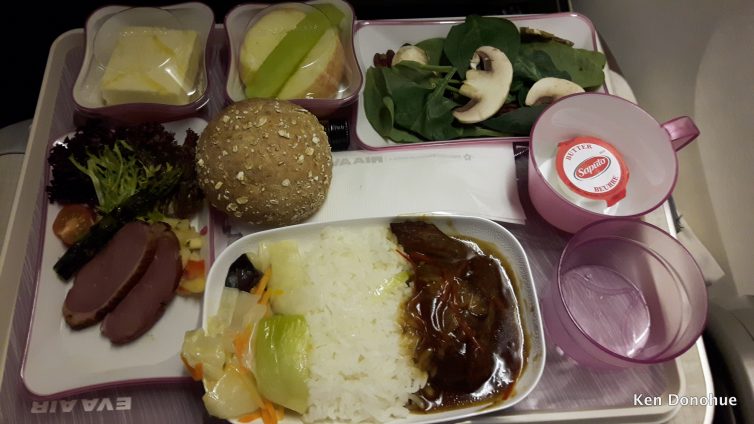
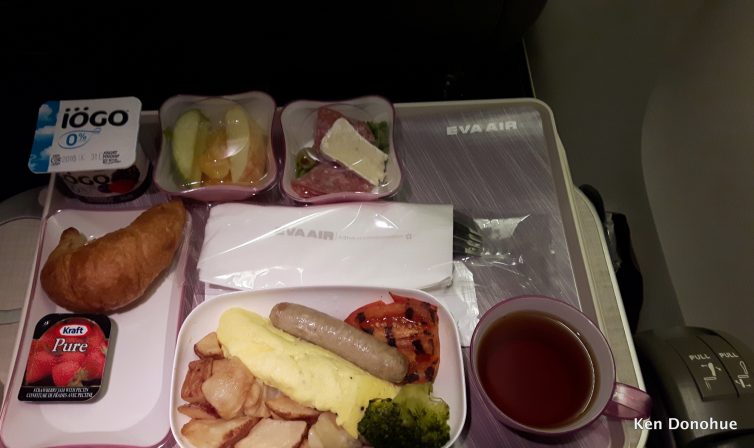
Great article. Love the 747 in all her versions. Even the three window upper deck 100 version. I have more hope the 800 will do well, but you make me sad saying she won’t be around long. I’m keeping my glass half full.
Andrew, I wish I could be optimistic, but looking at the industry and the order trend sadly we will see fewer ’47s.
Ken,
Based on all empirical facts I totally agree with you.
Emotionally, it makes me sad.
I love that big queen. 380 may be bigger, and have more tech, but it has no class.
Perhaps I’m old fashion?
Andrew: looks like the US Air Force 1 order will be the final two 747s off the production line, unless another airline steps up big-time, but I agree with you completely. The Jumbo is all elegance and class.
Fantastic read. Love that we are reading from a guest contributor. Gives us an opportunity to see the airline industry from a new set of eyes (not that i don’t enjoy the veteran A/R writers)
Have yet to fly on Eva but it is on my bucket list. Just need to find a friend who is willing to sit with me for 12 hours haha. I did have one question that I’m sure someone can answer. Why would BA operate 747’s in the winter and then switch to A380’s in the summer? Only guess I have is that it had to due with the fuel economy but that’s just a stab in the dark. Can anyone elaborate on that?
Thanks.
Mike,
BA’s decision to use the A380 in the summer months to Vancouver is actually a decrease in capacity from what they were offering. For the past few years, they had been operating 12 weekly (I think it was 12) 747 flights during the summer, so five days a week they had two flights a day, now they are just operating the A380 daily. It probably made sense to send one big plane , rather than the two. Despite Vancouver’s relative small size, there is a lot of demand on the London route, given historical and social links between the two.
Mike,
I am no true expert, just a true av geek. But my guess with ba switching seasonally has more to do with demand. Just my 2 cents thoughts. Anyone else know better?
More a demand and how full we can get the planes thing. What’s it called, the revenue per butt per mile type of thing.
Regardless, great read. I’m more than willing to take the 12 hr flight for fun!!
Actually, the change of leadership is not a big deal. They simply brought back the chairman from 2008 and promoted the president of its subsidiary Uni Air(which will be merging with BR soon), who was COO of EVA Air back in the 2000s, to be president.
Actually it was a huge scandal in Taiwan, because familial politics were involved. So it was a big deal.
Scott is right, it was an enormous deal. I’ll add a bit of background to add to his post:
Eva Air is a part of the Evergreen Group, which also owns a shipping line, a line of hotels, publishing houses, plus many other business ventures mainly in Taiwan. Back in January 2016, Evergreen founder and big-head-cheese Chang Yung Fah passed away, leaving his empire to 4 sons: 3 from his first wife, and one from his second. This last son, K.W. Chang, not only headed Eva Air, but is also a trained B777 pilot.
Upon Chang Yung Fah’s passing, K.W. claimed the chairmanship of Evergreen Group, by way of his father’s will, but while he captained his company’s B777’s scheduled flight to Singapore, his 3 half-brothers staged a boardroom coup, stating Chang Y.F.’s will was currently being contested, ousting not only K.W. but also all chairpersons loyal to K.W., even before he was wheels-down at SIN. K.W. resigned from Eva Air soon after.
And you are correct: Derek Chen was president of Uni Air between 2004 and 2014, and is now chairman of Eva.
And to add to the intrigue: K.W. Chang is working on founding a new airline: Hsing Yu.
What an outrageous article – b747 was a good aircraft – maybe the queen – but clearly the A380 has become the king. The A380 is better in style, in performance, the cabin is wider, quieter, the fuel consumption is lower. The b747 will soon be gone from the sky – and I will not miss this old slow grandfather aircraft.
The A380 was voted by passenger ‘best aircraft in the world’:
http://www.dailymail.co.uk/travel/travel_news/article-3355963/Airbus-A380-named-best-aircraft-world-time-Boeing-failed-bag-award.html
Anyway I feel sorry for you – some people look back – some people look ahead and see the A380.
While you’re completely correct about the passenger experience, the A380 has not had a single new order in over a year, and Airbus has stated it will never turn an operating profit, and will be cutting production rates to 1 a month in 2018. There is no second-hand market for off-lease A380s – SG’s early-build superjumbos are coming off lease with no takers, and MAS has had such rotten luck getting rid of their’s that they’ve resorted to creating their own sub-airline using those A380s as glorified Hajj coach buses, all in a stab-in-the-dark attempt to claw back losses.
(Never mind the fact the 747-8 is not doing better)
The future is twin-engined VLAs like the 777X, 787, and A350. These suit the routes and business models airlines are flying today – point-to-point routes, bypassing one or more hubs, with more frequency while needing less fuel and maintenance, than four-engine jumbos.
Phoenix, every airline that operates A380s has massive demand on A380 operated flights. Passengers love them. The main problem is that airline accountants hate them. I will fly on an A380, even if I have to pay a higher fare. You can’t beat the secure feeling of four engines on long ocean sectors. A Qantas A30 captain once told me: “If they made one with 5 engines, we’d buy that too”!
It’s interesting you bring up Qantas. They have outstanding orders for two more A380s but have so little interest in taking them they are paying Airbus to forever defer their order.
Sebastian, the only sensible post! The opening sentence “There is little question that the Boeing 747 is the most beautiful aircraft ever built” has one word wrong: substitute beautiful with ugly.
Greetings fellow Vancouverite Ken! It’s real unique to see both Taiwanese carriers fly 747s here, and it’s equally sad to see those same jumbos on their way out. I’m betting CI will place their new A350s on the TPE-YVR route, and BR will be subbing in the 777-300ER (and fingers-crossed, the 787-10 once introduced). Exciting and interesting times either way.
Back to BR: I’ve always known they were a solid airline, and your experience confirms it. I would be happy to fly them given sufficient reason and opportunity.
Lastly, awesome post! Looking forward to more!
ok, I’m sorry but that plane was such a disaster and i would never take it again… My friend and I flew TPE-MNL on the upper deck. We were sooo excited to try it and maybe had too high of the expectations (we usually don’t) and the only thing that was missing is chicken running around… there were literally boxes of stuff laying around, my char couldn’t stay in the upright position, TV was barely working, if you could see anything on that tiny screen… no thank you, 2 hour flight was more than enough…
I love flying on 747s, They are faster then their two engine counterparts (so flight times are typically quicker). These planes are big and roomy and there are lots of bathrooms so the line is never an issue. I hate flying on 3-3-3 seating arrangements because I am a window guy. If I don’t sit next to three people I know, it can make getting up very difficult (especially night flights). My favorite seats are the last three rows on either side. With new engine technology and cheaper fuel prices, maybe there is still hope for the queen of the sky.
Great piece and great photos, Ken. I didn’t know EVA had 747s active in their passenger fleet, since I only see their 77Ws flying around the US. Keep up the good work.
I had the opportunity to fly roundtrip on this BR744 on the exact same route last November. The reason why I chose BR instead of flying direct from HKG to YVR was that I could sit on the upper deck while paying only a very reasonable fare for its economy class seat, and thus fulfilling my wish of sitting on the upper deck of a 747 before their retirements.
I remember reading a report from this website about the same experience on a BR flight a while ago. And I would like to say that the most memorable experience, despite the relatively old infotainment system obviously, was how quiet the upper deck was except for the wind noise. I did not expect wind noise could be this obvious on the upper deck. Perhaps it was noticeable only because I could barely hear the engines? Usually I could hardly sleep on a long haul flight but I slept very well for 8 hours on the tranquil and small cabin of the upper deck.
The service was great; the attendants were young and friendly; and the food was the usual acceptable standard without any complaint. And these qualities should bring me back to BR in the future for flights from HKG to YVR via TPE especially with the introduction of their 773 on this route. Both CX and AC, unfortunately, do not treat us cattle class passengers the way they serve people (especially if you are a Caucasians may I add) up front, even though their aircrafts are much newer.
Good job BR, and thank you Ken. I enjoyed reading your trip report.
Thanks Louis, Even though it was a one-stop to Hong Kong, EVA operates an efficient hub at Taipei, so I was in Hong Kong by 9:00am. And the fares can often be very good. $700+ all in. With all the recent new entrants to China from YVR, there is a lot of capacity to Asia, and even more so with Air Canada starting Taipei service.
I think you’re wide of the mark saying that the 747 is the most beautiful passenger aircraft – beautiful it is, but no match for the timeless grace and elegance of Concorde. Here’s an aircraft which was designed over 60 years ago but still looks fresh (unfortunately no longer flying).
Reg,
Indisputably, the Concorde is a beautiful machine. Practical? No—gave a poor return on the investment. Its supersonic speed was limited to over water and its range was so restrictive, it couldn’t fly transPacific. Comfortable? No – hard little seats due to limited space and keeping everything as light weight as possible. At less than 5′ 11″, I could feel my hair brushing the ceiling as I walked down the aisle. And the airfare was 125% of First Class on the airlines’ other planes. Further, the aging planes were becoming difficult & very expensive to maintain. The entire BA Concorde fleet was found to be developing cracks in the wings. And after the French Concorde crashed in Paris, the passenger loads dropped off. So yeah, they make a pretty model airplane and they’re cool to see at air museums. Changing times require new & different aircraft, but the 747 was a beautiful AND financially rewarding aircraft for many years – it helped bring affordable air travel to the average traveler.
Did they mention an 11″ IFE screen? That can’t be correct, can it?
I coltempely agree! I'm a Size 8 too, but this summer I found myself buying long vest tops and floaty dresses in size 12 because they were so much cooler and prettier on me in the hot weather!
Perhaps have I misread the sentence about ‘…where EVA, China Airlines, Lufthansa, British Airways, and Qantas still have passenger operations with the type. Albeit, the latter three operate the aircraft only seasonally.’ I don’t believe Lufthansa uses B744/B748 seasonally as it has 13 and 19 units respectively.
Lufthansa has a daily B744 service between Frankfurt and Denver for years: initially, it started with A333 only to replace it with B744 shortly as the demand rose quickly. In addition, Lufthansa flies three B748, serving Buenos Aires, Rio de Janeiro, and São Paulo from Frankfurt every day.
One day, I flew from Buenos Aires (EZE) to São Paulo (GRU) where I transferred to the next flight to Rio de Janeiro (GIG). I saw one Lufthansa B748 parked at each aeroport, waiting for their return flight to Frankfurt. I don’t think I have ever seen so many B748 at separate locations in a single day outside Frankfurt.
Earlier this month, I had an opportunity to fly Business Class in Lufthansa B748 ‘Fanhansa’ from Rio de Janeiro to Frankfurt. I was awestruck with quiet engines even though I sat above the wing box (Seat 10K) and saw the right engines protruding from the beautiful wing. The most remarkable difference between -400 and -8 is lack of wing shake during the turbulence in the latter.
A personal note: my first ever flight was with Lufthansa B747-100 in November 1973 from Frankfurt to Chicago. Ever since, I have flown with every variation except -300, -400ER, and -SP.